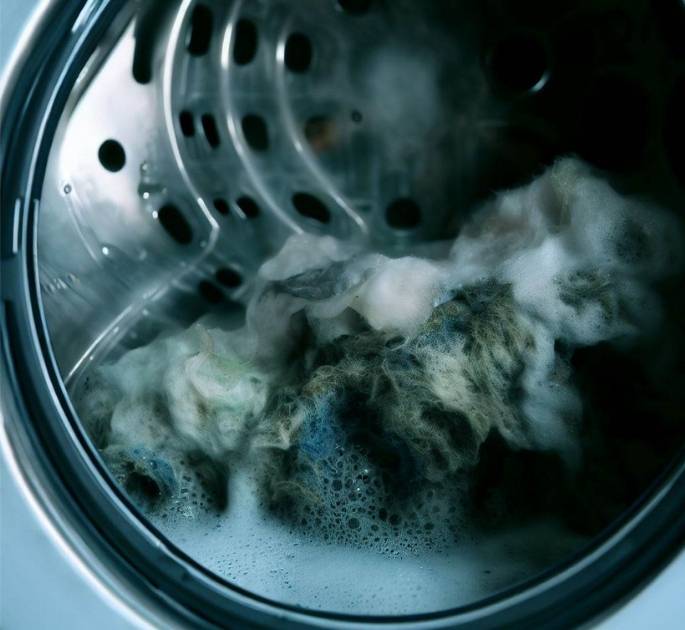Mold growth in washing machines is an issue that many homeowners overlook, often with detrimental consequences.
This seemingly innocuous problem can lead to a range of issues, from unpleasant odors to potential health risks.
In this blog post, we will look into how humidity levels in your home can significantly contribute to mold growth in washing machines.
By understanding the relationship between humidity and mold, you can take proactive steps for the prevention and control of mold growth, ensuring a healthier and cleaner laundry room.
Table of Contents
What is Humidity and How is it Measured?
Humidity refers to the amount of water vapor present in the air. It is a crucial factor that can influence various aspects of our daily lives, including the growth of mold in places like the laundry room and washing machines.
Ideal Humidity Levels for Preventing Mold Growth
The ideal indoor humidity level for preventing mold growth ranges between 30% and 50%.
Levels above 60% can create an environment conducive for mold and mildew to thrive.
How to Measure Humidity Levels?
Measuring humidity levels in your home is quite straightforward. You can use a hygrometer, a device specifically designed for this purpose. Digital hygrometers offer an easy-to-read display and are generally more accurate.
The Connection Between Humidity and Mold
High humidity and moisture settings are ideal for the growth of mold.
The presence of water vapor in the air creates an ideal setting for mold growth, especially when combined with other factors like temperature and nutrient-rich surfaces.
Scientific Facts Supporting the Connection
- Moisture and Mold Growth: When humid air comes into contact with a cold surface, it can create moisture or condensation. Surfaces that can provide nutrients become breeding grounds for mold in higher-humidity environments [1].
- High Relative Humidity: Mold flourishes in damp conditions where the relative humidity is typically above 70-80%. Elevated humidity levels create a favorable environment for mold to grow indoors [2].
- Temperature and Mold: Temperature is another critical factor that influences mold growth. Prediction models often consider temperature alongside humidity as abiotic factors affecting mold development [3].
- Moisture Requirement: Moisture is a fundamental requirement for mold growth. Changes in temperature can impact humidity levels, making it easier for mold to thrive in conditions with fluctuating humidity [4].
Understanding the scientific basis for how humidity affects mold growth is crucial for effective prevention and control measures in your laundry room and washing machine.
Specific Risks for Washing Machines

Why Washing Machines Are Vulnerable to Mold?
Washing machines are particularly susceptible to mold growth due to their primary function of cleaning clothes with water and detergent. This process inherently creates a moist environment, ideal for mold to flourish. Plus, the humidity in the laundry room, where washing machines are often located, can worsen this issue.
Additionally, residues from detergents and fabric softeners can provide the nutrients that mold needs to grow.
Areas Where Mold Typically Grows in Washing Machines
Door Seals and Gaskets: These areas are prone to moisture and condensation, making them a hotspot for mold.
Detergent Dispensers: Leftover detergent can create a nutrient-rich environment for mold growth.
Drum: If water is not fully drained or if clothes are left wet inside, it can lead to mold development.
Ventilation Ports: Poor ventilation can lead to stagnant air and increased humidity, encouraging mold to grow.
Drain and Filter: These areas can collect debris and water, providing another opportunity for mold to thrive.
How Humidity Levels Affect Washing Machines?
High levels of humidity in the laundry room can have a direct impact on your washing machine, making it a breeding ground for mold growth. When the air is saturated with moisture, it creates an environment where mold spores can easily multiply. This is especially problematic in closed spaces like the interior of a washing machine, where moisture and condensation can accumulate.
Factors Contributing to High Humidity Levels in Laundry Rooms
- Leaks: Any form of leaking, whether from the machine itself or from pipes, can increase moisture levels, thereby promoting mold growth.
- Poor Ventilation: Inadequate ventilation can trap humid air inside the laundry room, making it difficult to control humidity levels effectively.
- High-Humidity Activities: Activities like showering or bathing in proximity to the laundry room can significantly raise humidity levels.
- Leaving Wet Clothes: Wet clothes left in the washing machine or dryer can contribute to increased humidity, providing a conducive environment for mold to thrive.
Signs and Symptoms of Mold in Washing Machines
Signs of Mold Growth in Your Machine
- Unpleasant Odor: A musty or moldy smell is often the first sign of mold growth in your washing machine.
- Visible Spores: Black or green spores may appear on the door seal, drum, or other parts of the machine.
- Stained Clothes: If your clothes come out of the machine with unexplained stains, it could be a sign of mold.
- Reduced Efficiency: Mold and mildew can clog filters and reduce the efficiency of your machine.
- Water Pooling: Excess water that doesn’t drain properly can be a breeding ground for mold.
Symptoms of Mold Exposure
Exposure to mold can lead to various health issues, particularly for those who are sensitive or allergic to mold:
- Respiratory Problems: Breathing difficulties, wheezing, and coughing can occur [5].
- Skin Irritation: Contact with mold can lead to rashes or other skin irritations [6].
- Headaches: Mold exposure can cause headaches or exacerbate migraines [7].
- Eye Irritation: Red, itchy eyes are another common symptom [8].
Recognizing these signs and symptoms is crucial for taking timely prevention and control measures to mitigate the risks associated with mold growth in washing machines.
Mitigating Risks: Controlling Home Humidity
How to Prevent Mold Growth in Washing Machines?
- Keeping Humidity Levels Low: The first step in preventing mold growth in washing machines is to maintain a humidity level between 30% and 50% in your laundry room. This can be monitored using a hygrometer.
- Ventilating the Laundry Room: Proper ventilation is essential for controlling humidity. Make sure to use exhaust fans or open windows to circulate air and reduce moisture.
- Cleaning the Washing Machine Regularly: Regular cleaning and disinfecting of your washing machine, especially areas prone to mold like door seals and detergent dispensers, can go a long way in prevention.
- Promptly Drying Wet Clothes: Do not leave wet clothes in the washing machine or dryer as it can contribute to increased humidity and mold growth.
Products That Can Help
- Dehumidifiers: These devices can effectively reduce moisture levels in the air, making it less conducive for mold to grow.
- Moisture Absorbers: Products like silica gel can absorb excess moisture and are useful for small, enclosed spaces like washing machine drums.
- Air Purifiers: Some air purifiers come with mold-fighting filters that can help in reducing mold spores in the air.
Additional Risks and Preventative Measures
Dangers of Mold Growth in Washing Machines
- Spread of Mold Spores: One of the most concerning risks of mold growth in washing machines is the potential for spores to spread to other areas of your home, exacerbating health risks and contaminating living spaces.
- Damage to the Machine: Over time, mold can cause significant damage to the internal components of your washing machine, affecting its efficiency and lifespan.
Additional Factors Contributing to Mold Growth
- Inadequate Cleaning: Failing to clean your machine regularly can lead to the buildup of soap scum and grime, providing more nutrients for mold.
- Use of Cold Water: Washing with cold water may not effectively kill mold spores, making it easier for mold to grow.
- Irregular Use: If the machine is not used regularly, stagnant water can become a breeding ground for mold.
- Lack of Sunlight: A laundry room that lacks natural light can create a damp environment, conducive for mold growth.
- Poor Maintenance: Neglecting regular maintenance checks can lead to unnoticed leaks and malfunctions, contributing to mold development.
When to Seek Professional Help?

If you notice signs of mold growth in your washing machine, immediate cleaning and disinfecting are crucial. Here are some steps you can follow:
- Empty the Machine: Remove any clothes and run an empty cycle with hot water.
- Use Vinegar and Baking Soda: Add a cup of white vinegar and a half-cup of baking soda to the drum and run another hot water cycle.
- Scrub Affected Areas: Use a scrub brush to clean the door seals, detergent dispensers, and other areas where mold is visible.
- Run a Final Rinse: Run one last cycle with just hot water to rinse away any remaining cleaning agents.
In order to remove the mold thoroughly from your washing machine you can follow the comprehensive guide to remove mold from washing machine here.
Hiring a Professional Mold Remediation Company
For severe mold problems that are beyond the scope of DIY cleaning, it may be necessary to hire a professional for mold remediation, here’s how to go about it:
- Research and Reviews: Look for companies with good reviews and ask for recommendations from friends or family.
- Certification: Ensure the company is certified in mold remediation and follows industry standards.
- Inspection and Quote: A professional should inspect the affected areas and provide a detailed quote for the remediation process.
- Timeline and Process: Discuss the timeline and the steps involved in the remediation process.
Monitoring and Quality Assurance
After taking steps to mitigate mold growth in your washing machine and laundry room, it’s crucial to regularly monitor humidity levels.
This ensures that your prevention and control measures are effective in the long term.
Using a hygrometer to check humidity levels and making adjustments to your ventilation and moisture control strategies can help maintain a mold-free environment.
Final Thoughts
Controlling humidity levels is extremely important for preventing mold growth in clothes washers.
A balanced humidity level not only keeps your machine in optimal condition but also ensures a healthier living environment.
To sum up, here are the tips that you should keep in mind always:
- Use a dehumidifier to maintain optimal humidity levels.
- Ensure proper ventilation in the laundry room.
- Regularly clean and disinfect your washing machine.
- Be vigilant about fixing leaks and drying wet clothes promptly.
You May Also Like
- Clean Your Washing Machine Detergent Drawer in 5 Mins
- How to clean Maytag washing machine? (Comprehensive guide)
- How to clean the filter in a Godrej Allure washing machine?
- How to use Tide Washing Machine Cleaner?
- How to Clean a Top Load Washing Machine? (Ultimate Guide)
- How to clean the washing machine filter top loader?
- How do you clean the washing machine agitator?

